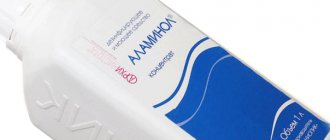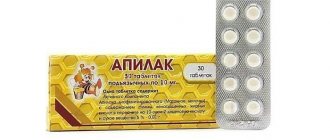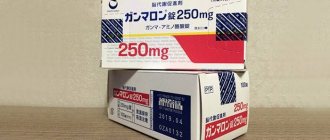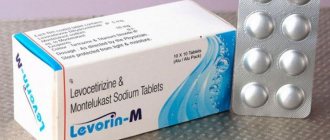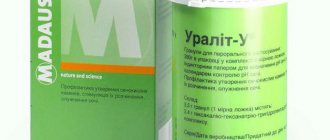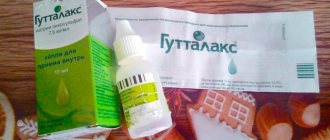Release form
The drug Artrosan is available in two dosage forms:
- Light yellow cylindrical tablets Artrosan containing 7.5 and 15 mg of meloxicam. Excipients: lactose monohydrate, trisodium citrate, magnesium stearate, potato starch, povidone and colloidal silicon dioxide. 20 tablets in contour packs;
- Greenish-yellow transparent solution for intramuscular administration, containing 6 mg of meloxicam in 1 ml. In ampoules of 2.5 ml, 3 and 10 ampoules per package.
Pharmacological properties
Meloxicam is a non-steroidal anti-inflammatory drug (NSAID), belongs to enolic acid derivatives and has anti-inflammatory, analgesic and antipyretic effects, according to the artrosan instructions.
The pronounced anti-inflammatory effect of meloxicam has been established in all standard models of inflammation.
The mechanism of action of meloxicam is its ability to inhibit the synthesis of prostaglandins, known mediators of inflammation. Meloxicam in vivo inhibits the synthesis of prostaglandins at the site of inflammation to a greater extent than in the gastric mucosa or kidneys.
Pharmacodynamics
These differences are due to more selective inhibition of cyclooxygenase-2 (COX-2) compared with cyclooxygenase-1 (COX-1). Inhibition of COX-2 is thought to mediate the therapeutic effects of NSAIDs, whereas inhibition of the constitutively present isoenzyme COX-1 may be responsible for gastric and renal side effects.
The selectivity of meloxicam for COX-2 has been confirmed in various test systems, both in vitro and in vivo. The selective ability of meloxicam to inhibit COX-2 was demonstrated when using human whole blood as a test system in vitro.
It was found that meloxicam (in doses of 7.5 and 15 mg) more actively inhibited COX-2, having a greater inhibitory effect on the production of prostaglandin E2 stimulated by lipopolysaccharide (reaction controlled by COX-2) than on the production of thromboxane, which is involved in the blood coagulation process (reaction controlled by COX-1).
These effects were dose dependent. Ex vivo studies have shown that meloxicam (at doses of 7.5 mg and 15 mg) has no effect on platelet aggregation and bleeding time.
In clinical studies, gastrointestinal (GIT) side effects were generally less common with meloxicam 7.5 and 15 mg than with other NSAIDs compared.
This difference in the frequency of side effects from the gastrointestinal tract is mainly due to the fact that when taking meloxicam, such phenomena as dyspepsia, vomiting, nausea, and abdominal pain were observed less frequently. The incidence of upper gastrointestinal perforations, ulcers and bleeding associated with meloxicam use was low and dose dependent.
Pharmacokinetics
Absorption. Meloxicam is completely absorbed after intramuscular administration. The relative bioavailability compared to oral bioavailability is almost 100%. Therefore, when switching from injection to oral forms, dose selection is not required.
After administration of 15 mg of the drug intramuscularly, the peak plasma concentration (about 1.6 - 1.8 μg / ml) is achieved within approximately 60 - 96 minutes.
Distribution. Meloxicam binds very well to plasma proteins, mainly albumin (99%). Penetrates into synovial fluid, the concentration in synovial fluid is approximately 50% of the concentration in plasma. The volume of distribution is low, approximately 11 L. Individual differences are 7–20%.
Metabolism. Meloxicam is almost completely metabolized in the liver to form 4 pharmacologically inactive derivatives. The main metabolite, 5-carboxy-meloxicam (60% of the dose), is formed by oxidation of the intermediate metabolite, 5-hydroxymethylmeloxicam, which is also excreted, but to a lesser extent (9% of the dose).
In vitro studies have shown that the CYP2C9 isoenzyme plays an important role in this metabolic transformation; the CYP3A4 isoenzyme is of additional importance. Peroxidase is involved in the formation of the other two metabolites (constituting, respectively, 16% and 4% of the drug dose), the activity of which probably varies individually. Removal
It is excreted equally through the intestines and kidneys, mainly in the form of metabolites. Less than 5% of the daily dose is excreted unchanged in feces; the drug is found unchanged in urine only in trace amounts. The average half-life of meloxicam varies from 13 to 25 hours.
Plasma clearance averages 7–12 ml/min after a single dose. Meloxicam exhibits linear pharmacokinetics at doses of 7.5–15 mg when administered intramuscularly.
Insufficiency of liver and/or kidney function. Insufficiency of liver function, as well as mild renal failure, do not have a significant effect on the pharmacokinetics of meloxicam. The rate of elimination of meloxicam from the body is significantly higher in patients with moderate renal failure.
Meloxicam binds less well to plasma proteins in patients with end-stage renal failure. In end-stage renal failure, an increase in volume of distribution may result in higher concentrations of free meloxicam, so in these patients the daily dose should not exceed 7.5 mg.
Elderly patients. Elderly patients compared to young patients have similar pharmacokinetic parameters. In elderly patients, the average plasma clearance during steady-state pharmacokinetics is slightly lower than in younger patients. Elderly women have higher AUC values (area under the concentration-time curve) and a longer half-life compared to younger patients of both sexes.
Contraindications
According to the instructions, Artrosan is contraindicated for use in:
- Exacerbation of peptic ulcer of the stomach and duodenum;
- “Aspirin” bronchial asthma;
- Severe liver and kidney failure;
- Hypersensitivity to the active substance - meloxicam or other components of tablets and solution for injections Artrosan.
Lactation and pregnancy are also contraindications to the use of Artrosan. Injections are not used under the age of 18, tablets - up to 15 years.
Doctors' opinion about the drug
Deryabin I.M. An effective non-steroidal anti-inflammatory drug with minimal side effects compared to other drugs in this group. The optimal combination of price and quality. No allergies have been reported during use.
I use it successfully for moderate vertebrogenic pain syndromes. For long-term use, it should be combined with omeprazole.
Lisenkova O. A. Russian Meloxicam, more affordable than the original Movalis. Well tolerated.
The original drug, in my opinion, is always preferable to the generic, but it is not always possible and financial to get the original one. "Artrosan" is a worthy copy of "Meloxicam". There is a place for it in my practice.
Tyazhov N.I. An excellent drug, well tolerated, effective and inexpensive! We often prescribe it for the treatment of osteochondrosis, especially in the acute phase, for acute inflammatory diseases of muscles and joints, and in complex therapy. Side effects from the gastrointestinal tract are extremely rare, and they went away on their own after discontinuation of the drug.
Dulkin M.R. Good analgesic effect. A fairly effective drug in the treatment of various pain syndromes, in particular, vertebrogenic radiculopathies, as well as osteoarthralgia, muscle-tonic pain syndromes, in combination with muscle relaxants, has a persistent anti-inflammatory and analgesic effect.
Afanasyev-Kadomtsev S.A. It is not inferior in effectiveness to Movalis, but the price is half the price. Exacerbation of gastric ulcer, duodenal ulcer.
A good drug for the combined treatment of moderately severe muscle and joint inflammatory processes. That is, for arthrosis, arthritis, myositis. The pain syndrome is relieved within 3-4 days. After parenteral administration, transfer to the oral form is necessary. Take it for another week. "Omez" or "Famotidine" 20 mg 1 time per day is required for the period of treatment.
Prokhorov D.E. Meloxicam is optimal for the combined treatment of moderately severe muscle and joint inflammatory processes. Side effects from the gastrointestinal tract, in my opinion, are less common than other NSAIDs.
In terms of price, Artrozan is half the price of Movalis, although it is not inferior in effectiveness. Perhaps the most frequently prescribed drug by me today.
Directions for use and doses
Artrosan injections are used only in the first few days of treatment, once a day, 7.5 or 15 ml, after which treatment is continued with tablets. Due to the risk of side effects, the drug is recommended to be used in minimal effective doses. Artrosan injections should only be administered intramuscularly and it is not recommended to mix the drug in the same syringe with other medications.
Artrosan tablets are taken once a day, preferably with meals. The maximum daily dose is 15 mg. The dosage depends on the disease:
- For osteoarthritis, take one tablet of Artrosan 7.5 mg; if there is no effect, the dose can be doubled;
- The recommended daily dose for rheumatoid arthritis is 15 mg; after improvement, the dose can be reduced to 7.5 mg per day;
- For ankylosing spondylitis, take one Artrosan 15 mg tablet per day.
According to the instructions for Artrosan, an overdose may cause epigastric pain, impaired consciousness, nausea, respiratory arrest, vomiting, acute renal and liver failure, and asystole.
Caution should be exercised when using Artrosan simultaneously with antihypertensive drugs, methotrexate, diuretics, cyclosporine, lithium preparations and some other drugs. The risk of bleeding from the gastrointestinal tract increases with simultaneous use of Artrosan with other non-steroidal anti-inflammatory drugs, including acetylsalicylic acid.
Artrosan is used with caution in case of a history of erosive and ulcerative lesions of the gastrointestinal tract and in old age.
Description of the drug
Artrosan (meloxicam) is a new generation drug from the group of NSAIDs (non-steroidal anti-inflammatory drugs), one of the representatives of selective inhibitors of the cyclooxygenase enzyme (COX-2). These substances are involved in the biological synthesis of prostaglandins formed in the area of inflammation.
The medicine belongs to enolic acid derivatives from the oxames group, characterized by high bioavailability. The harmful effect of arthrozan on the gastric mucosa is minimal.
What is Arthrozan prescribed for? It has anti-inflammatory, analgesic, and slight antipyretic effects, which allows it to be used for degenerative lesions of the spine and joints.
Side effects
Arthrozan, reviews confirm, can cause various undesirable effects:
- Exacerbation of bronchial asthma and cough;
- Confusion of thoughts, headache, tinnitus, dizziness, disorientation and sleep disturbance;
- Hematuria, interstitial nephritis, edema, urinary tract infection, renal medullary necrosis, proteinuria, renal failure;
- Anemia, thrombocytopenia, leukopenia;
- Increased blood pressure, tachycardia, feeling of hot flashes;
- Vomiting and nausea, abdominal pain, esophagitis, stomatitis, diarrhea or constipation, perforation of the stomach or intestines, dry mouth. Much less often, Artrosan, according to reviews, causes flatulence, hepatitis, colitis and increased activity of liver enzymes;
- Conjunctivitis and blurred vision;
- Increased photosensitivity and fever;
- Anaphylactoid reactions, skin rash, allergic vasculitis, erythema multiforme exudative, swelling of the lips and tongue, toxic epidermal necrolysis, itching and urticaria.
Artrosan's analogs
There are a large number of analogues of Artrosan, which cost much less. But, at the same time, the relatively low cost of the drug is associated with a cheaper substance used to manufacture the drug, as well as savings in the production process (lower degree of purification, use of low-quality auxiliary media).
Therefore, the savings in this case are doubtful. In addition, Artrosan is a domestic drug from the well-known company Pharmstandard, the price of which is more affordable than the foreign original drug Movalis, and their quality and ease of use do not differ.
Which dosage form is preferable: injections or tablets? As a rule, for acute pain, the course of treatment is prescribed with injections, used for no more than 3 - 5 days. For ease of use, Artrosan ampoules containing meloxicam 0.006/ML 2.5 ML are available in packs of 3 pieces. Then it is recommended to switch to tablets until the end of the course of treatment.
When chosen as an analgesic and anti-inflammatory drug, diclofenac is often used. What is better to use in injections: diclofenac or arthrozan?
- artrosan can be used much longer than diclofenac;
- artrosan is a chondroneutral drug, i.e. does not have a negative effect on cartilage;
- Compared to Diclofenac, Artrosan has side effects in fewer cases.
In addition, in the treatment of diseases of the joint-ligamentous apparatus, drugs containing Analgin, in particular Baralgin, are often used to relieve a pain attack. This medicine has earned wide popularity.
What to prefer: Baralgin or Artrosan? Both drugs have a rapid analgesic effect, the effect of its use develops within a few minutes. However, Baralgin contains Analgin, which is banned in a number of countries due to its detrimental effect on hematopoiesis and the development of drug addiction.
